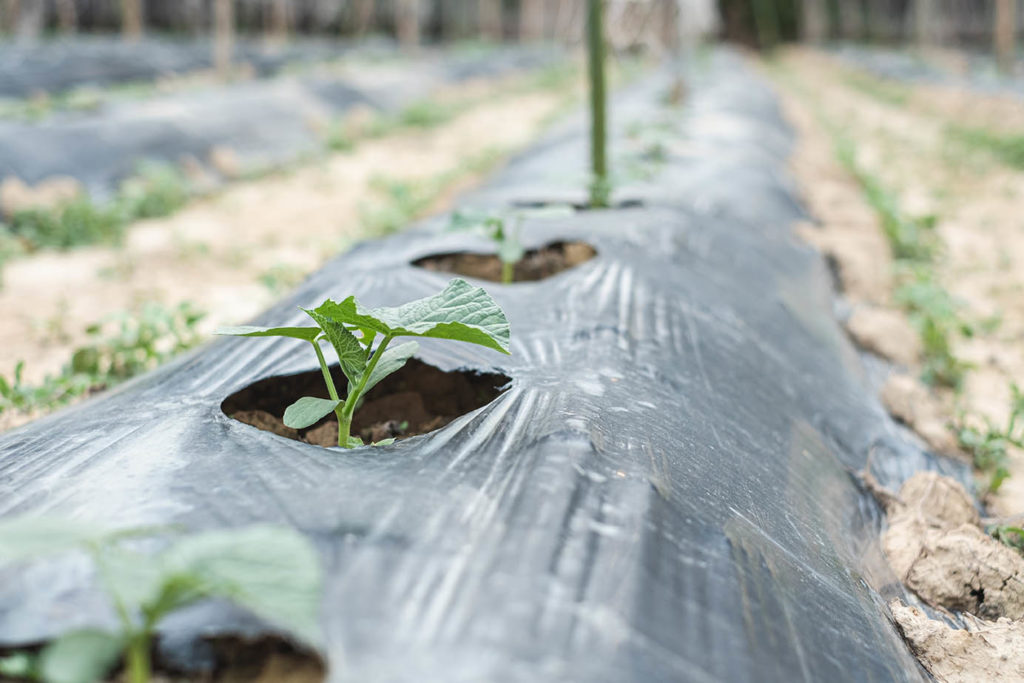By Ramdas Kanissery

Weed management is fundamental in successfully growing vegetables in Florida using a plasticulture system. Traditionally, this production system was reliant on fumigants like methyl bromide to control various soilborne diseases, nematodes and weeds. However, the phaseout of methyl bromide resulted in a lack of broad-spectrum activity and consistency in weed suppression in plastic mulched raised beds.
This is particularly true for tough weeds such as nutsedge (Cyperus spp.), which can pierce the plastic and thrive in the mulched and irrigated raised beds (Figure 1). Furthermore, nutsedge tubers can remain viable in the soil for several years and serve as primary means of survival. Hence, additional options such as herbicide may be needed to suppress the emergence of weed seeds and tubers in plastic mulched beds.

AN EFFECTIVE OPTION
Herbicides can be utilized as a weed-suppression tool under the plastic mulch in vegetable production to reduce the competition from weeds and enhance productivity. University of Florida Institute of Food and Agricultural Sciences (UF/IFAS) studies have shown that pre-emergent (or residual) herbicide s-metolachlor (Trade name: Dual Magnum) can effectively suppress nutsedge in plastic mulched beds (Figure 2).

Also, the use of pre-emergent herbicide under plastic mulch can potentially have a positive impact on crop yield. For example, in a preliminary UF/IFAS study, transplanted bell pepper yield was 48% to 57% lower when herbicide was not applied under the plastic mulch, possibly due to the competition from weeds like nutsedge.
Herbicides are usually needed under the plastic mulch if the soil is not fumigated; however, herbicide may also be applied regardless of fumigation. In fact, herbicide application used in conjunction with soil fumigation may enhance weed control effectiveness, mainly if the pressure from weeds such as nutsedge is excessive. For instance, when fumigants are injected through drip irrigation, pre-emergent herbicides help manage the weeds on the bed edge that are out of reach of injected fumigants.
Nevertheless, herbicide use under plastic mulch is often challenging. First of all, there are only a few herbicide options that exist for use under plastic mulch. Secondly, the potential for herbicide-related crop injury is reasonably high under plastic mulch. Following are some strategies to help optimize herbicide use under plastic mulch.
PREPARATION AND APPLICATION
Prepare the pressed bed first, then apply the herbicide to the bed surface. Spraying herbicides on flat ground and pressing raised beds is not recommended, as it may cause crop injury and impact plant establishment. When the beds are formed in this way, the herbicide will be incorporated too deeply into the soil and may encounter the roots of transplanted crops.
Be sure to calibrate herbicide sprayers properly and maintain a constant spray pressure and tractor speed (e.g., 3 miles per hour) while applying herbicides on the pressed beds.
Remember that among the various herbicides used in vegetable production in Florida, only a few can be used on raised beds under plastic mulch. Selecting a low herbicide usage rate from the labeled product rates is suggested for application under plastic mulch.
Also, be mindful of the precautions and restrictions specified on the product label. If previous experience is lacking with applying a specific herbicide product under plastic mulch, consider making treatments on a small scale before doing it on the whole farm.
For more information on herbicides approved to use under plastic and their rate suggestions in Florida-grown vegetables, consult the Vegetable Production Handbook of Florida published by UF/FAS Extension.
SOIL MOISTURE CONSIDERATIONS
Lay the plastic mulch after spraying herbicides on the pressed beds. One point to consider is that most herbicide products used under plastic mulch are very sensitive to moisture and often require it to activate them. Optimal soil moisture always benefits herbicide application under plastic mulch as the condensation from soil moisture under the mulch will help “activate” the herbicides in many instances.
If dry soil conditions prevail on the farm, providing overhead irrigation (e.g., 0.5 inches) before laying plastic may promote the activation, and hence effectiveness, of certain herbicide products. On the other hand, maintaining very high soil moisture after herbicide application in the beds is unfavorable as it may promote the leaching or movement of susceptible herbicides to the root zone of the new transplants.
STRATEGIES FOR CHALLENGES
One of the challenges when using herbicides under plastic mulch is avoiding injury to the transplants (Figure 3). This is especially true while using water-wheel transplanters, which could reactivate the herbicide applied under the plastic mulch and concentrate it around the rooting area of the transplant. This risk can be potentially avoided by making the planting hole relatively small.

Other strategies include tank-mixing spray adjuvants such as soil deposition or adsorption agents with the herbicides to restrict the movement of herbicides in the raised beds when the soil is predominantly sandy. Preliminary results from a recent UF/IFAS study suggest that soil deposition aids (Example trade name: Grounded®) may be used to enhance the crop safety of pre-emergent herbicides like s-metolachlor under plastic mulch by restricting herbicide movement into the root zone of tomato transplants.
SUMMARY
Herbicides are a great option to suppress weed emergence in plastic mulched beds. Only a few herbicides are approved to use under plastic mulch. Hence, observing the crop-specificity and restrictions on product labels is crucial. Also, by adopting strategies such as selecting a lower application rate, maintaining the optimal soil moisture in beds, and using adjuvants such as soil adsorption agents, the effectiveness and crop safety of herbicides used under plastic mulch can be enhanced.
Ramdas Kanissery is an assistant professor at the UF/IFAS Southwest Florida Research and Education Center in Immokalee.









